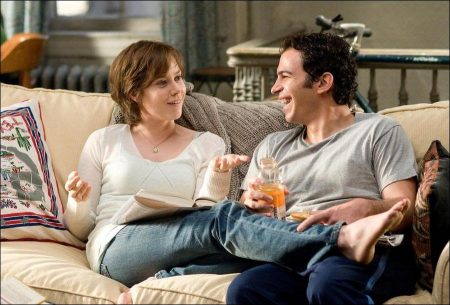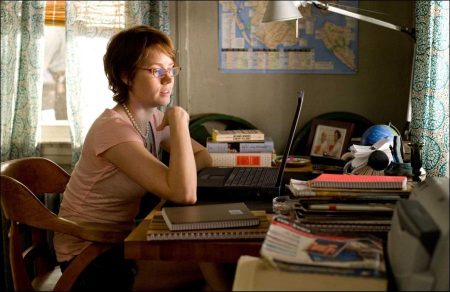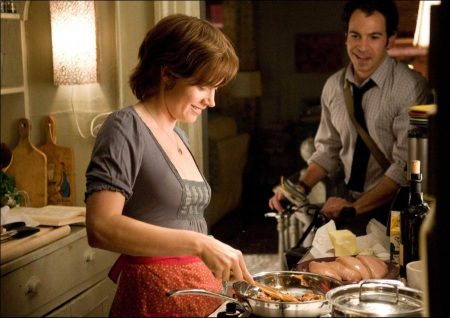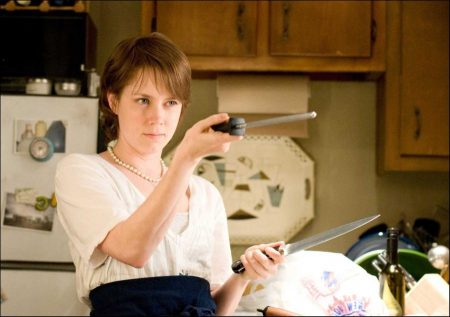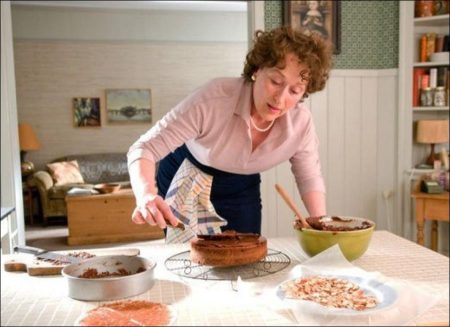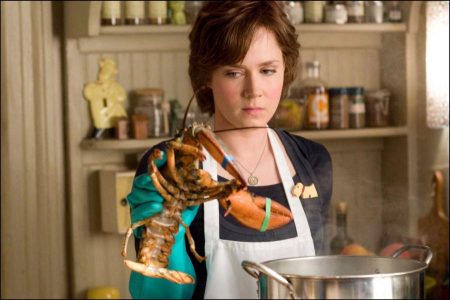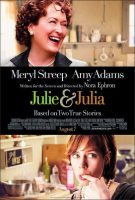Taglines: Passion. Ambition. Butter. Do You Have What It Takes?
Julie and Julia movie storyline. Based on Julie Powell’s book “Julie & Julia: 365 Days, 524 Recipes, 1 Tiny Apartment Kitchen.” Julie Powell recounts how she conquered every recipe in Julia Child’s Mastering the Art of French Cooking and saved her soul. Julie Powell is 30-years-old, living in a rundown apartment in Queens and working at a soul-sucking secretarial job that’s going nowhere. She needs something to break the monotony of her life, and she invents a deranged assignment. She will take her mother’s dog-eared copy of Julia Child’s 1961 classic Mastering the Art of French Cooking, and she will cook all 524 recipes. In the span of one year.
At first she thinks it will be easy. But as she moves from the simple Potage Parmentier (potato soup) into the more complicated realm of aspics and crepes, she realizes there’s more to Mastering the Art of French Cooking than meets the eye. With Julia’s stern warble always in her ear, Julie haunts the local butcher, buying kidneys and sweetbreads. She sends her husband on late-night runs for yet more butter and rarely serves dinner before midnight. She discovers how to mold the perfect Orange Bavarian, the trick to extracting marrow from bone, and the intense pleasure of eating liver. And somewhere along the line she realizes she has turned her kitchen into a miracle of creation and cuisine. She has eclipsed her life’s ordinariness through spectacular humor, hysteria, and perseverance.
Before Ina, before Rachael, before Emeril, there was Julia, the woman who forever changed the way America cooks. But in 1948, Julia Child (Meryl Streep) was just an American woman living in France. Her husband’s job has brought them to Paris, and with her indefatigable spirit, she yearned for something to do. Fifty years later, Julie Powell (Amy Adams) is stuck. Pushing 30, living in Queens and working in a cubicle as her friends achieve stunning successes, she seizes on a seemingly insane plan to focus her energies. Julie decides to spend exactly a year cooking all 524 recipes in Julia Child’s Mastering the Art of French Cooking (which Child co-wrote with Louise Bertholle and Simone Beck) and write a blog about her experiences.
About the Production
“It’s about love, it’s about marriage, it’s about changing your life,” says Ephron of the themes that motivated her to make Julie & Julia. “I’m obsessed with food, but there were at least eight other reasons why I had to do it, like doing things you care about and finding happiness through that.” “What unites these two stories is passion,” says producer Laurence Mark. “Julie Powell and Julia Child both discovered a passion – in each case, a passion for food – that got them through tough or uncertain times. The movie is also about marriage – how it’s a delicate balancing act. Julie and Julia have both somehow figured this out, and no matter the ups and downs, they’re crazy about their spouses and their spouses are crazy about them.”
The film takes the remarkable approach of adapting and interweaving two celebrated memoirs: Julie & Julia by Julie Powell and My Life in France by Julia Child with Alex Prud’homme. My Life in France is Child’s own story of her years in post-World War II Paris as the wife of American foreign-service employee Paul Child, when she was able to turn her ardor for French cooking into a dedicated mission to spread its pleasures to American households. After becoming the first American woman to study at the famous Cordon Bleu cooking school, she popularized French cuisine in America by co-writing the English-language cookbook Mastering the Art of French Cooking. The book’s popularity led to a cooking show career that made her a household name in the United States.
More than anyone else, Child steered American eaters away from the canned, the frozen and the processed and into food that was fresh, flavorful and made with unbridled joy, a wonderful metaphor for approaching life. “When you talk about passion, Julia Child didn’t just have it for her husband or cooking, she had a passion for living,” says Streep. “Real, true joie de vivre. She loved being alive, and that’s inspirational in and of itself.”
A half-century later, in 2002, New Yorker Julie Powell was nearing 30, dissatisfied as a writer, and facing an emotionally depleting day job working for an organization devoted to rebuilding the World Trade Center site after 9/11 and helping displaced residents resettle. Spurred to change her life, she decided to cook her way through Child’s masterpiece – 524 recipes in 365 days – and chronicle her efforts in a blog. With the encouragement of her husband Eric—who was happy to devour the fruits of her labors—Julie began detailing the ups and downs of her time-consuming project. Today, blogging is part of the fabric of our lives, but in 2002, Powell was a blogging pioneer.
Mark says, “I think at the outset of this endeavor, Julie may not have realized just how ambitious it actually was. But since she was clearly getting a kick out of it, and the results were so delicious, it all became somewhat more manageable.” Powell’s writings became so popular that, like Child, she got her own culinary adventure published: Julie & Julia: My Year of Cooking Dangerously was released by Little, Brown in 2005.
But before Powell even had a book deal, producer Eric Steel had taken notice of her, including in a New York Times profile written by food writer Amanda Hesser. “Julie was really one of the first bloggers to sort of break out of the tiny orbit that some of these people live in,” Steel explains. “She had a real audience. By the time I found her, she had thousands of people reading her blog every day.”
At the same time producer Amy Robinson was looking to turn the love story of Julia and Paul Child into a movie. Hearing about Steel’s option on the rights to Powell’s story, Robinson proposed the two combine their narratives. “I thought, ‘You can combine these two things, these two marriages, these two women looking to find who they are,’” says Robinson.
Clothing: A Tall Order
Creating the world of Julie & Julia meant in effect bringing to life two separate movies: one relatively contemporary, the other a period piece taking place fifty years ago. For the Julia Child segments, Academy Award®-winning costume designer Ann Roth — who has worked many times with Meryl Streep on such films as Doubt, The Hours, and Mamma Mia! — found herself re-creating an era with which she was very familiar, having lived through it herself.
“The life of Julia Child was something I know a lot about,” she says, “and I know what people wore at that time. I knew what the girdle was, and the glove and the hat, and when you wore a hat and when you wore a glove, and how many sweaters you had and how many cashmere sweaters you didn’t have. It’s a life that I knew very well. I mean, I was in school in the ‘50s. So I felt pretty secure in that period.” Roth had previously called upon her memories and research for her Academy Award®-nominated costume designs for The Talented Mr. Ripley, which took place in the same period.
Asked to describe Julia Child’s style, she laughs. “I don’t think she was hooked on fashion! I would describe it as captain of the hockey team,” says Roth. “She was a hardy girl who was six-foot-two. You don’t walk into any store and find skirts and shirts that size. It must have been very, very difficult to dress her. I assume that she –her family, her mother–probably went to Bullock’s Pasadena and had a lady there who sent her clothes to school for her, you know, as was done at that time.”
The memory most people have of Julia Child’s attire is from the way she dressed on her television show, that iconic three-quarter-sleeve cotton shirt and denim apron. However, those shirts are impossible to find now. Contemporary fabrics have Lycra in them so that they will fit closer to the body; in addition, the darts and the collar in such tops are designed differently. Roth had to have Julia’s shirts specially made in order to faithfully re-create her TV look.
For the scenes taking place in the late 1940s and early 1950s, Julia would be garbed in proper “lady” clothes of the era— quality suits, hats, and, of course, embroidered monograms on blouses and pajamas. “She wore stockings with seams,” says Roth, “but she was also a girl who would play badminton in the garden in her shorts and bare legs.” Julia Child towered over most people in her presence. A primary challenge for Roth was creating and maintaining the illusion of great height for Meryl Steep.
“You can’t keep saying, ‘Well, we’ll just hire four-foot or five-foot people and put her on an apple box.’ So we made four or five pair of experimental shoes, and I thought they would be difficult to walk in, to act in. But it turned out that they worked quite well. All the fittings for Julia were done with that height, with that length of leg. We cheated on where the waistline was, we cheated all over the place, and we made a figure that was what I saw as Julia Child. And then, of course, her husband was this perfect smaller person. A very dapper one. His suits were made for him. As were his father’s, as were his father’s fathers and his uncles–he came from that kind of family. Not that he was rich; he was never rich, but he was spiffy.”
Production Design
While Ann Roth was researching costumes, production designer Mark Ricker and his crew took over two huge stages at Silvercup East Studios, across the East River from Manhattan, to build a whole series of kitchen sets—some eleven in all, most of which were period kitchens from the mid-20th century for the Julia Child scenes.
“All had to be functional, working kitchens,” says Ricker “And they had to have every implement that you could possibly imagine for Meryl, for Nora, for Amy. It all had to be there. So it wasn’t just the presentation of the food, it was the implementation of the food. And it informed everything that we did, and it just had to be great. I think Nora used the word ‘pornographic’ at one point to describe the level of what the food should be in this film, so we all knew the food was going to be a major element in determining what the look of the film would be.”
The first kitchen to be completed, however, was the Powells’, as the “Julie” part of the film would be shot first, with the “Julia” section to follow during the latter half of the production schedule. Ricker was able to visit the actual apartment on Jackson Avenue in Long Island City where Julie and Eric had lived, and recreated it at Silvercup East.
“I was thrilled to find out that there was a tin detail in her apartment that had a fleur de lis repeated throughout” – fleur de lis being the motif on the famous Child cookbook – “all the way up the staircase. We went to the apartment and took a mold of that and incorporated it into Julie’s apartment set that we built on stage.” Ricker says that what they built at Silvercup East was pretty close to the square footage of the Powells’ real place. “It wasn’t a tiny space that they lived in,” he says.
“It was scripted as nine hundred square feet and that’s about what we built, and I think that’s about what she lived in. The basic through-flow of the apartment was pretty accurate. It was essentially one big room, with an ‘L’ off one side. The kitchen was in the middle, as we did it. Hers was actually a little bit bigger than the one that we built, but you could see how it would have been difficult for her to get through this cookbook, squirreled away in the kitchen that she had – you know, one sink, one stove and one small refrigerator.”
Julie’s climactic rooftop feast for her friends was filmed on a balmy late spring night in Long Island City. The atmosphere was appropriately celebratory; it was nearing the end of Amy Adams’s and Chris Messina’s filming, with the Meryl Streep-Stanley Tucci part of the movie set to begin shooting the following week.
“That was a really magical moment,” Amy Adams remembers. “and there was just an overall sense of peace and happiness with the whole crew that evening. I took several mental photographs of that evening, because it was just beautiful. There we were all up on a rooftop and there was a real sense of community. And I think that’s what’s great about New York in late spring when everybody comes out of their hibernation and there’s such a sense of community. You really had that feeling.”
Food, Glorious Food
“We hope you leave this movie wanting something to eat,” says producer says producer Laurence Mark. With such a delectable subject as French cuisine, the filming of Julie & Julia was marked by the constant presence of food. So many scenes involved food preparation and consumption that matters of quality and authenticity were paramount. This was the domain of culinary consultant Susan Spungen and executive chef Colin Flynn, both of whom brought years of experience in restaurant work and food journalism to this unusual temporary job.
Spungen had served as the founding editorial director for food and entertaining at Martha Stewart Living Omnimedia and launched Everyday Food, the company’s first all-food title. Spungen also authored two cookbooks, one with Stewart, and currently writes about food for several publications.
Chef Flynn graduated from the French Culinary Institute before taking on positions at the prestigious Manhattan restaurants Bayard and Zoe; he eventually became sous-chef at Alison on Dominick. Their work on Julie & Julia required them to prepare all the food used in the film and to serve as technical advisors.
Nearly every day of filming at the studio, the stage would be filled with the aromas of that particular day’s onscreen menu. Spungen and Flynn had their own kitchen area built onto each stage, where they worked wonders turning out multiple versions for multiple takes of everything from bruschetta to boeuf bourguignon to boned duck. “We didn’t get anything sent back,” jokes Flynn. Ephron says what really impressed her about Spungen’s work was that they had to pull off a form of character-based cooking.
In other words, the meals shouldn’t signal to the audience that a trained chef was at hand. “Susan’s a genius, because she made sure the food in the movie looked like a normal person made it,” says Ephron. Often, Flynn and Spungen were called upon to make gargantuan amounts of rather demodé dishes rarely seen on contemporary menus, such as Lobster Thermidor for a dinner scene involving six eaters.
That one required numerous takes over the course of the day. During the scenes showing the prep work for that evening, Amy Adams had to act with live lobsters take after take. When it came time to eat them on camera, Adams begged off, pleading for fake lobster meat instead. “Cooking them in the scene before just traumatized me,” she says with a rueful laugh. “And now I cannot eat lobster anymore.”
Though Streep is a home cook and Adams took classes before filming got underway, both were coached in French cooking techniques by Spungen, including the deboning of that duck, not to mention the trick of flipping an omelet. “That was a difficult scene to coordinate, because we had to get all these actors playing students in the Cordon Bleu to flip their omelets at the same time along with Meryl,” says Spungen. “We gave Meryl some on-the-spot last-minute omelet-flipping lessons in our kitchen before she went on to film the scene. But she aced it, she was brilliant. She can swing a fish around in a piece of cheesecloth without anyone’s coaching.” Streep says the biggest thing she took away from her culinary scenes was the importance of good knives.
“Chopping onions is a breeze if the thing is nice and heavy and has a great edge,” says Streep. “As Julia says, ‘Always wash your knives, sharpen them, dry them and put them away.’ A sharp knife is everything!” Aside from the onscreen food, of which there was plenty, by late afternoon on filming days Nora Ephron and executive producer Don Lee would often have special treats delivered to the set for the entire cast and crew.
These could be anything from the best chicken in Harlem to barbecued ribs from Brooklyn to fabulous sweets delivered by pastry chefs. Then, at wrap time, all the leftovers from the day’s filming were brought out for the cast and crew to finish off. Nearly everyone packed on serious pounds during the three-month shoot.
From New York to Paris
Once the Julie Powell section of filming was completed, the Julia Child portion began, and cast and crew were plunged fifty years into the past. At Silvercup East Studios, production designer Mark Ricker and his team designed and built an exquisite version of the home Julia and Paul shared in Paris. “They lived in a great house, by the Seine,” says Ricker. “I actually had two photographs that I designed most of the apartment from. There was one that’s quite well known, of Julia leaning out a window next to this beautiful curved sunroom. We just replicated that, because how could we not? We couldn’t have come up with anything better.
There was also a picture of Paul and Julia sitting by their fireplace. We replicated that corner and then the apartment just grew from that. Everything else was from imagination, aside from the kitchen, because Paul had taken a number of publicity photos of it. By the time I stitched all the photos together in my mind, I had a 360-degree view of the kitchen, and it was just fantastic. It was up in the rafters of the house, with a beautiful window, great details. And so we just replicated it as much as we could – the tiles, the stove, the sink – everything. Because it was just great.” As for the iconic TV studio kitchen that so many people remember from Julia’s legendary series “The French Chef,” Ricker did a lot of his research from her own papers, photographs and letters.
“She left a treasure trove of information, including a lot of photographs of the ‘French Chef’ set,” says Ricker. “So with the combination of having behind-the-scenes photos and just being able to look straight at the DVD, we did the best we could to replicate a set that millions of people are familiar with. That was going to be the one that, of anything, people would know. So we had to get that right.” When it came to exteriors, it was clear to the filmmakers that certain scenes could only be captured in Paris. Ephron was thrilled to bring her movie’s Julia Child to the place where she really blossomed.
“When you see Paris,” recalls Ephron, “you think, well, what else could we have done?” “It was Paris that inspired Julia Child to love food and to master the art of French cooking,” says Mark. “It was eating that very first Sole Meunière in France that transported her and began to change her life. She realized her fantasy, and it happened in Paris. Just being there, I think, may have inspired Meryl’s performance and Stanley’s, too.” Following two days of prep, the five-day span of Paris location filming took place with seemingly effortless clockwork efficiency. Numerous company moves midway through shooting days were accomplished so smoothly that as many as three or four locations per day could be filmed.
There was little in the way of delays, and even the weather cooperated, which was lucky because all shots scheduled were exteriors, with no cover sets planned. Paris has kept so much of its character over the years that, for most of the locations, little or no set-dressing was required in order to reset the scene to the late 1940s and early 1950s. Much of the filming was concentrated close to the Seine on the Left Bank, in the Fifth and Sixth arrondissements, and around the neighborhoods of St. Michel and St. Germain des Prés.
Sites included the famous Shakespeare and Company bookstore, the Place Ste.-Geneviève, an outdoor café near the Place Maubert, and several bridges over the Seine. The central commercial street of the charming Ile St.-Louis was where Julia took her cooking students food shopping, and the park behind Notre Dame on the neighboring Ile de la Cité served for some of Stanley and Julia’s strolls.
A bit further afield, at the foot of Montmartre, was the art nouveau-era bakery where Julia goes to buy her morning croissants. Perhaps the biggest scene shot in Paris, which required several days of prep and a full day of filming, took place on the Rue Mouffetard, a charming, narrow street in the Fifth arrondissement that is one of the oldest in the city.
For generations its lower half has spent weekday mornings as an outdoor market. It is here that Julia really begins to discover her love for Paris and her burgeoning interest in cooking. “The narrowness of the street, the rooflines, the cobblestones—everything made it the right location for us,” says Mark Ricker. “We needed to redress six facades to put them back to the right era, but so much of what we needed was already right there waiting for us.”
By the time principal photography wrapped, nearly everyone involved with Julie & Julia had come to greatly appreciate the role sheer enthusiasm plays not just in cooking, but in finding the recipe for personal fulfillment. Passion unites each of these leading characters through their toughest times and their most triumphant moments, leaving the taste of fulfillment the sweetest one of all. “Both women had setbacks, both decided to do something very hard, and both succeeded,” says Ephron.
Julie and Julia (2009)
Directed by: Nora Ephron
Starring: Meryl Streep, Amy Adams, Stanley Tucci, Chris Messina, Jane Lynch, Dave Annable, Mary Lynn Rajskub, Helen Carey, Linda Emond, Joan Juliet Buck, Vanessa Ferlito, Casey Wilson
Screenplay by: Nora Ephron
Production Design by: Mark Ricker
Cinematography by: Stephen Goldblatt
Film Editing by: Richard Marks
Costume Design by: Ann Roth
Set Decoration by: Susan Bode
Art Direction by: Ben Barraud
Music by: Alexandre Desplat
MPAA Rating: PG-13 for brief strong language and some sensuality.
Distributed by: Columbia Pictures
Release Date: August 7, 2009
Views: 121
